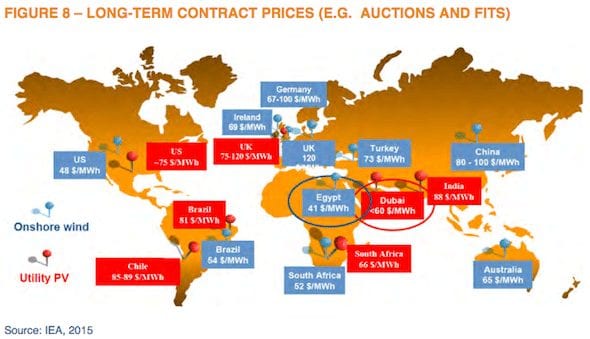One week after Australia’s two major political parties agreed to slash the funding of one of the nation’s top renewable energy support mechanisms, a report has been released by the World Energy Council stressing the importance of government policies in the global shift to low-carbon energy.
The report, Variable Renewables Integration in Electricity Systems 2016 – How to get it right, was published on Tuesday and draws on 32 country case studies – Australia is not one of them – representing about 90 per cent of installed wind and solar capacity worldwide.
It notes that renewable energy sources, including hydro, now account for more than 30 per cent of the total global installed power generation capacity and 23 per cent of total global electricity production, after charting “explosive average annual growth” over the past decade; including 23 per cent for wind and 50 per cent for solar PV.
The report also notes how much the cost of renewable energy generation has fallen, driven down by improving technologies and reductions in development and operation costs. Recent data, it says, suggests the lowest auction value for wind is a tariff of $US28/MWh in Morocco and $US30/MWh for an 800MW solar PV plant in Dubai (although this figure may now have been beaten).

As the chart above shows, Australia – and this is the only mention Australia gets in the entire 140-page report – has many of the ingredients necessary for the successful integration of renewable energy generation, including some impressively low auction prices for wind and solar. But still it lags behind on policy.
In 2015, 164 countries around the world had renewable energy support policies in place in 2015 – 95 of them developing countries, compared with 15 in 2005. But of course, as Australia has demonstrated only too well, the quality of execution of these policies is all-important.
“The success of both the development of intermittent renewables and their efficient integration in electricity systems fundamentally depends on the right market design and regulatory framework and solid regional planning to avoid bottlenecks,” said Christoph Frei, the Secretary General of the World Energy Council, in a statement accompanying the report.
“We are beyond the tipping point of grand energy transition. Implementing technically and economically sound, stable policies supported by clear carbon price signals will enable this transition and take us a step closer to meeting the climate aspirations agreed at COP21.”

This viewpoint was echoed by Alessandro Clerici, who is chair of the Renewable Energy Sources Integration in Electricity Systems knowledge network.
“Appropriate technologies and policies, including regulation and market design play a fundamental role in both development of variable renewables and their efficient integration in electricity systems,” Clerici said.
“What works in any particular country depends both on its individual circumstances and the quality of execution of policies. A holistic and long-term approach to system design is key when planning Variable Renewable Energy Sources integration, including honest and transparent cost assessment to incentivise investment and ensure supply security and a robust energy sector regardless of a country’s resources or geographic location.”
Beyond policy measures, the report highlights lessons learnt from various countries’ experience in rolling out renewables; identifies critical success factors and highlights “concrete measures” for successful renewables integration in electricity systems.
Among its key recommends include the definition of market rules to ensure the transformation of a country’s energy system is in line with the objectives of the “Trilemma”, including clearly defined CO2 emissions regulations; the introduction of capacity markets to help ensure security of supply; and the further development of forecasting methodologies to achieve better accuracy from wind and solar generation.








